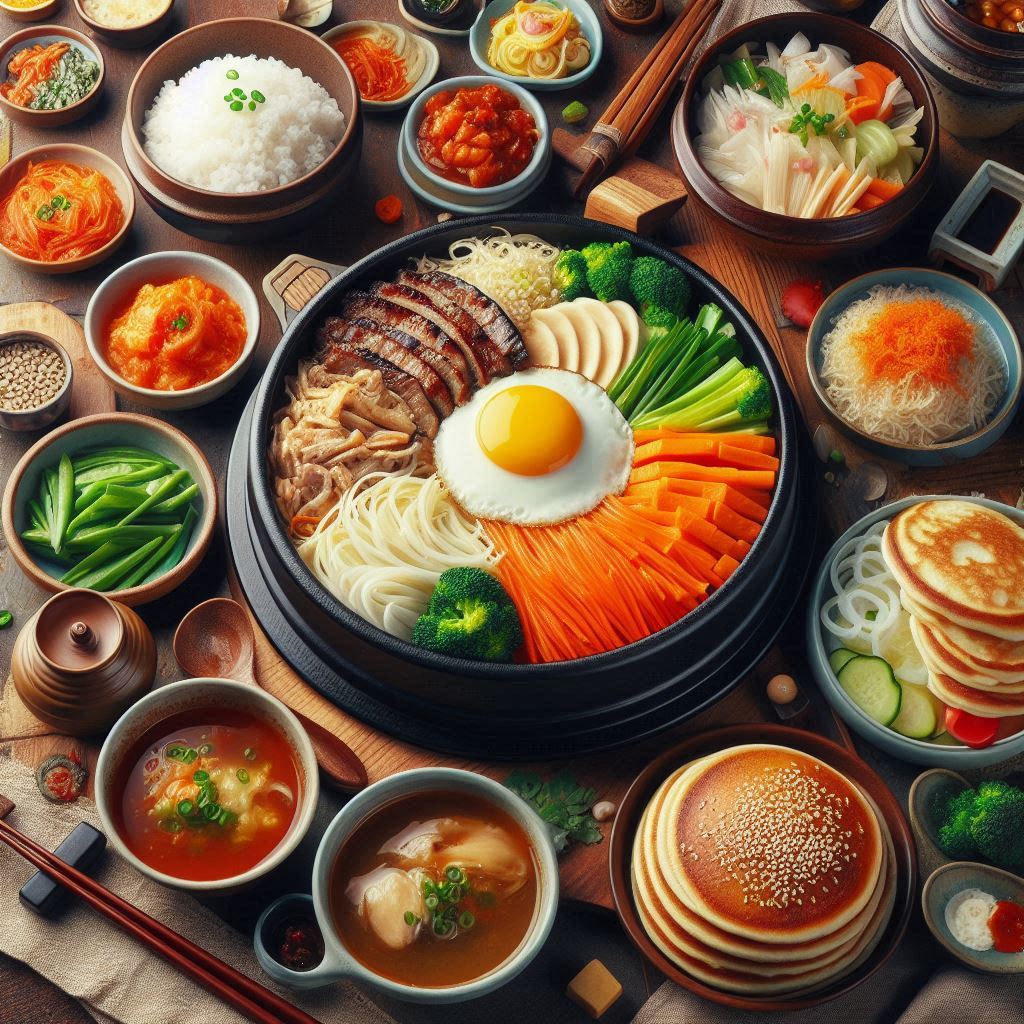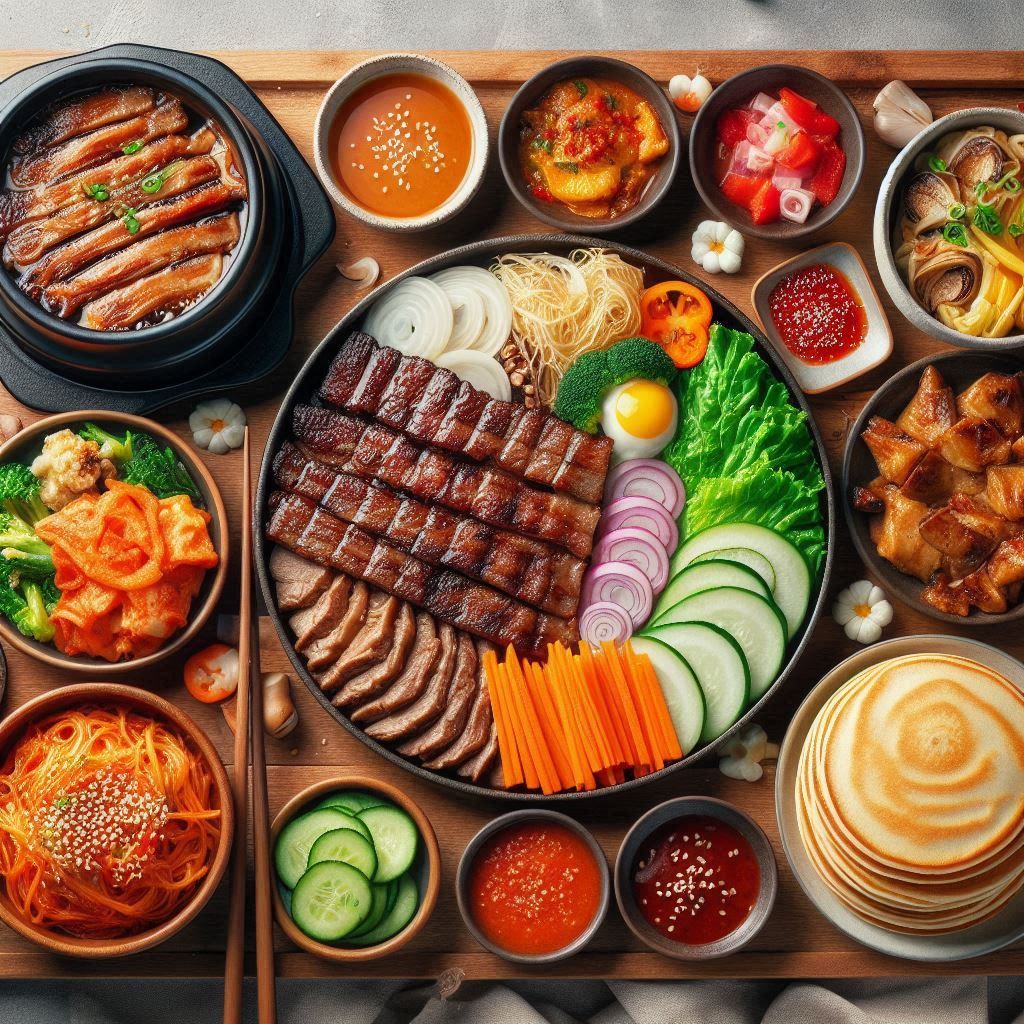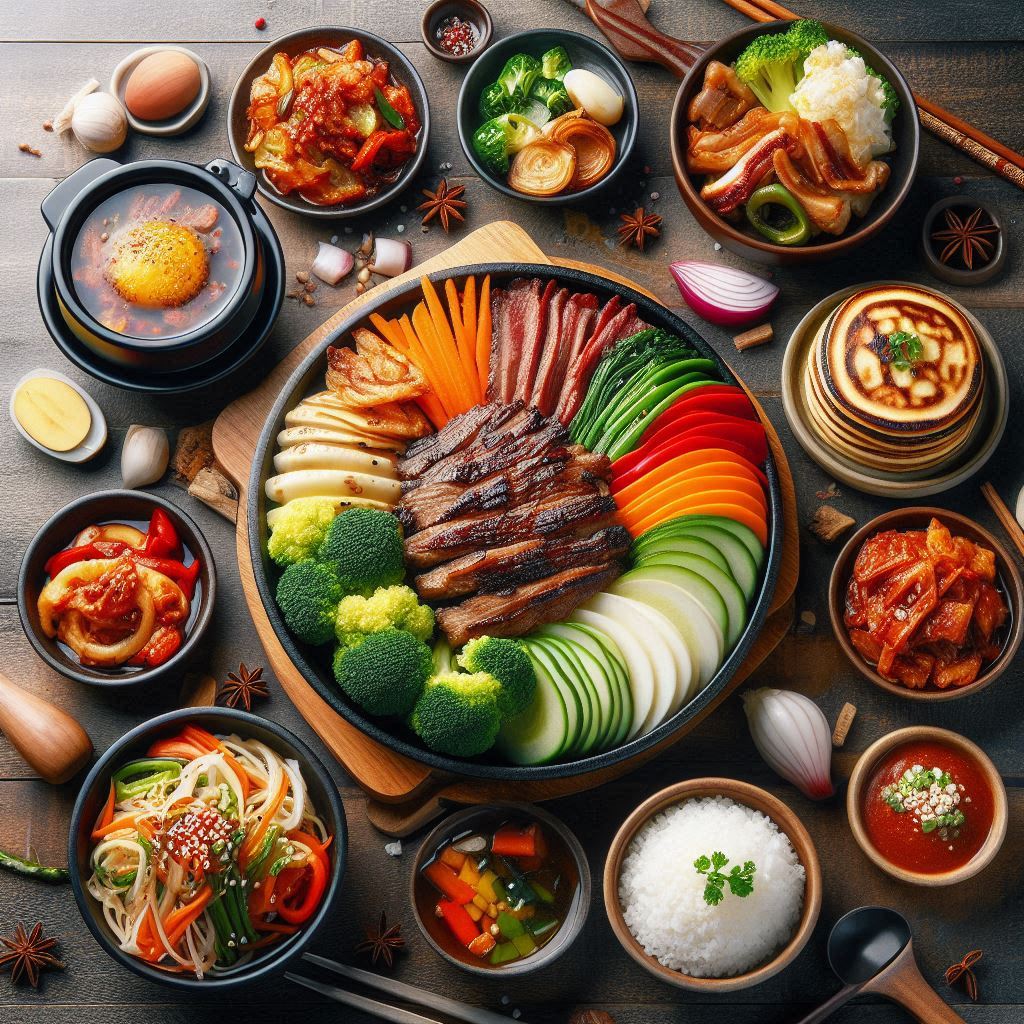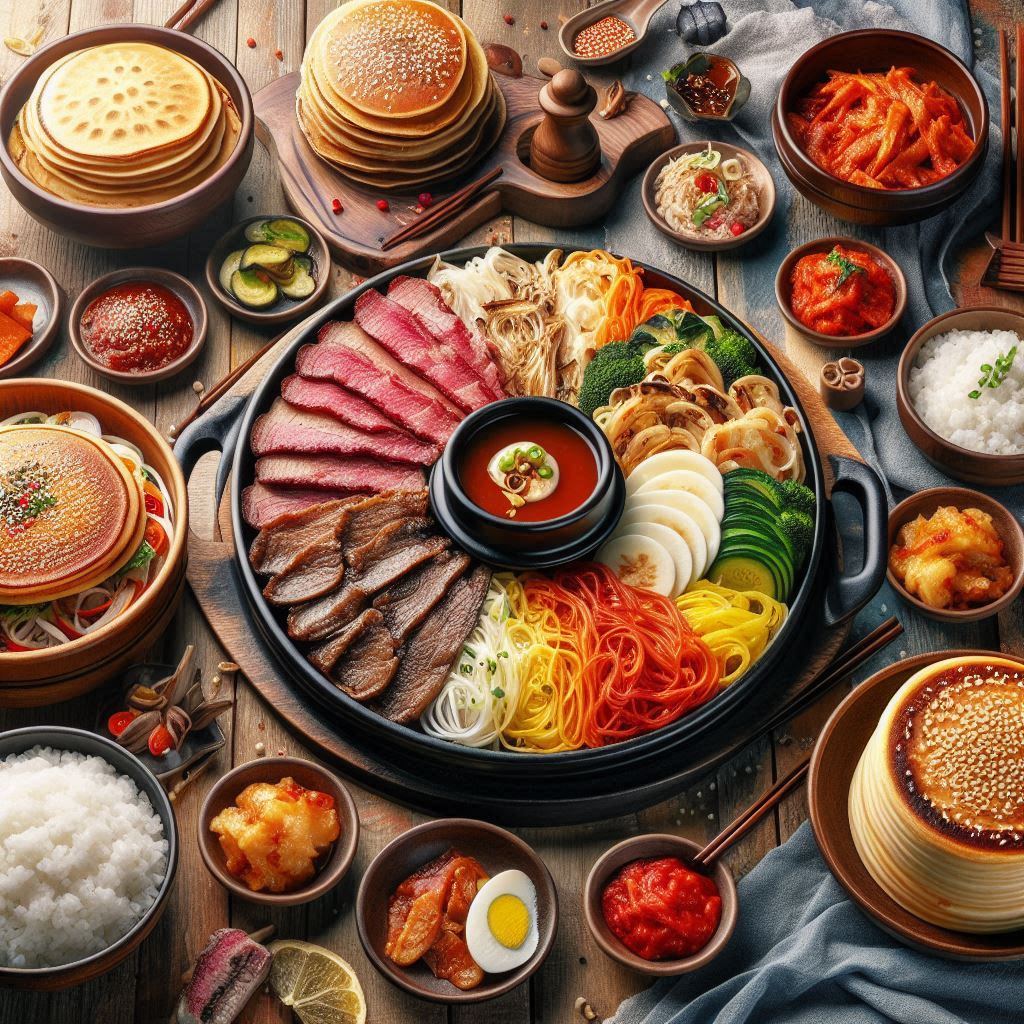韓國前十大美食的詳細介紹及其製作方法。
韓國以其獨特的飲食文化和豐富的美食聞名於世。以下是韓國前十大美食的詳細介紹及其製作方法。
1.韓國烤肉(Bulgogi):經典的韓國菜,通常用牛肉製作。首先,將牛肉切成薄片,用醬油、糖、梨汁、蒜末、蔥花、芝麻油和黑胡椒腌製至少30分鐘。然後,在燒熱的平底鍋或烤架上烤至肉片熟透且略帶焦糖色澤,配以生菜、蒜片和辣椒醬一起食用。
2.泡菜(Kimchi):韓國的國民小菜,通常用白菜製作。製作過程包括將白菜切塊並用鹽水浸泡數小時以去除水分。然後,製作醬料,混合紅辣椒粉、魚露、蒜末、薑末、蔥花和糖。將醬料均勻地塗抹在每一片白菜葉上,將其密封發酵數天到數週。完成後的泡菜可以單獨食用或作為其他料理的配料。
3.韓國拌飯(Bibimbap):色香味俱全的韓國主食。首先,煮好米飯並裝在大碗中。將各種配菜如炒菠菜、豆芽、胡蘿蔔絲、蕨菜、煎蛋和牛肉絲依次擺在米飯上。最後,加入適量的韓式辣椒醬(Gochujang)和芝麻油,食用時拌勻即可。
4.韓國辣炒年糕(Tteokbokki):受歡迎的韓國街頭小吃。首先,將年糕和魚糕切成適當大小。製作醬汁,用辣椒醬、糖、蒜末、醬油和水混合。將年糕和魚糕放入平底鍋中,倒入醬汁,煮沸後轉小火,持續攪拌直至年糕變軟並且醬汁變稠,最後撒上蔥花即可。
5.韓國煎餅(Pajeon):韓國的傳統煎餅,通常用蔥製作。首先,製作麵糊,將麵粉、水和雞蛋混合,然後加入切好的蔥段。將混合物倒入熱油鍋中,煎至兩面金黃酥脆。可以根據口味加入海鮮如蝦或魷魚。煎餅通常配以醬油、醋和辣椒粉調製的蘸醬食用。
6.韓國泡菜鍋(Kimchi Jjigae):用泡菜製作的韓式火鍋。首先,將豬肉或五花肉切片,與泡菜一起放入鍋中,加入切片的豆腐、洋蔥和蔥花。倒入高湯,加入少許鹽、糖和韓國辣椒粉。煮沸後轉小火煮至所有材料入味即可。
7.韓國炸雞(Korean Fried Chicken):外酥內嫩的韓式炸雞。將雞翅或雞腿用鹽、胡椒和大蒜粉腌製,然後裹上薄薄的一層麵粉和玉米澱粉混合物。將雞肉放入熱油中炸至金黃酥脆。製作調味醬,用韓國辣椒醬、蜂蜜、醬油和蒜末混合,將炸好的雞肉裹上醬汁,撒上白芝麻即可。
8.韓國牛尾湯(Seolleongtang):道傳統的牛骨湯,湯頭濃白。首先,將牛尾和牛骨洗淨,放入水中煮沸去血水,然後重新加水長時間煮熬至湯變白。煮好後,加入蔥花、鹽和胡椒調味,食用時可以加入米飯和泡菜。
9.韓國石鍋拌飯(Dolsot Bibimbap):特別的韓式拌飯,用熱石鍋盛裝。首先,將石鍋加熱,塗上一層芝麻油,然後放入煮好的米飯。依次放上炒好的菠菜、豆芽、胡蘿蔔絲、蕨菜、煎蛋和牛肉絲,最後加上一勺韓式辣椒醬,讓鍋底形成金黃色的鍋巴,拌勻後食用。
10.韓國辣牛肉湯(Yukgaejang):辛辣且營養豐富的韓國牛肉湯。首先,將牛肉(通常用牛腩)煮熟並撕成條狀。製作湯底,用牛肉高湯、韓國辣椒粉、蒜末和醬油混合,加入牛肉條、豆芽、蕨菜和切片的洋蔥,煮至所有材料入味即可。這道湯通常配以米飯和泡菜食用。
這些韓國美食展示其飲食文化的豐富多樣,每一道菜都有其獨特的風味和製作方法。無論是本地人還是遊客,都能在品嚐美食的過程中感受到韓國的熱情和傳統。
Korea is renowned for its unique culinary culture and diverse array of delicious foods. Here are detailed descriptions and preparation methods for the top ten Korean dishes:
Korean BBQ (Bulgogi): This classic Korean dish is typically made with beef. First, slice the beef thinly and marinate it with soy sauce, sugar, pear juice, minced garlic, chopped green onions, sesame oil, and black pepper for at least 30 minutes. Then, cook the marinated beef slices on a heated skillet or grill until they are fully cooked and slightly caramelized. Serve with lettuce leaves, garlic slices, and chili paste.
Kimchi: This national side dish of Korea is usually made with napa cabbage. The preparation involves cutting the cabbage into pieces and soaking it in salt water for several hours to remove excess moisture. Then, make a sauce by mixing red pepper powder, fish sauce, minced garlic, minced ginger, chopped green onions, and sugar. Evenly apply the sauce to each cabbage leaf and seal it in a container to ferment for several days to weeks. The finished kimchi can be eaten on its own or used as an ingredient in other dishes.
Bibimbap: This colorful and flavorful Korean dish consists of rice topped with various ingredients. Start by cooking the rice and placing it in a large bowl. Arrange sautéed spinach, bean sprouts, julienned carrots, fernbrake, a fried egg, and beef strips on top of the rice. Finally, add a dollop of Korean chili paste (Gochujang) and sesame oil, and mix everything together before eating.
Spicy Rice Cakes (Tteokbokki): A popular Korean street food. Begin by cutting the rice cakes and fish cakes into bite-sized pieces. Make the sauce by mixing chili paste, sugar, minced garlic, soy sauce, and water. Place the rice cakes and fish cakes in a skillet, pour in the sauce, bring to a boil, then reduce to a simmer. Stir continuously until the rice cakes are soft and the sauce thickens. Sprinkle with chopped green onions before serving.
Korean Pancake (Pajeon): A traditional Korean pancake usually made with green onions. First, prepare the batter by mixing flour, water, and an egg. Add chopped green onion stalks. Pour the mixture into a heated, oiled pan, and fry until both sides are golden and crispy. You can also add seafood such as shrimp or squid according to taste. Serve with a dipping sauce made of soy sauce, vinegar, and chili powder.
Kimchi Stew (Kimchi Jjigae): This stew is made with kimchi. Begin by slicing pork belly or pork shoulder and placing it in a pot along with kimchi, sliced tofu, onions, and green onions. Add broth, a pinch of salt, sugar, and Korean chili powder. Bring to a boil, then reduce to a simmer and cook until all ingredients are well incorporated and flavorful.
Korean Fried Chicken: Crispy on the outside and tender on the inside, this Korean fried chicken is a favorite. Marinate chicken wings or drumsticks with salt, pepper, and garlic powder. Coat them lightly with a mixture of flour and cornstarch. Fry the chicken in hot oil until golden and crispy. Make a sauce by combining Korean chili paste, honey, soy sauce, and minced garlic. Toss the fried chicken in the sauce and sprinkle with sesame seeds.
Korean Oxtail Soup (Seolleongtang): This traditional beef bone soup has a rich, milky broth. Clean the oxtails and beef bones, then boil them in water briefly to remove impurities. Rinse the bones and oxtails, add fresh water, and simmer for several hours until the broth turns milky white. Season with green onions, salt, and pepper. Serve with rice and kimchi.
Stone Pot Bibimbap (Dolsot Bibimbap): A special version of bibimbap served in a hot stone pot. Heat the stone pot and coat it with a layer of sesame oil. Place cooked rice in the pot and top it with sautéed spinach, bean sprouts, julienned carrots, fernbrake, a fried egg, and beef strips. Add a spoonful of Korean chili paste. Let the pot continue to heat until a golden crust forms at the bottom. Mix well before eating.
Spicy Beef Soup (Yukgaejang): A spicy and nutritious beef soup. Boil beef brisket until tender and shred into strips. Make the broth with beef stock, Korean chili powder, minced garlic, and soy sauce. Add the shredded beef, bean sprouts, fernbrake, and sliced onions to the broth and simmer until everything is well incorporated. This soup is typically served with rice and kimchi.
These Korean dishes showcase the richness and diversity of Korean culinary culture, each offering unique flavors and preparation methods. Whether for locals or visitors, these foods provide a taste of Korea's warmth and tradition.




照片:DALLE3
- 1
- 2
- 3
- 4
